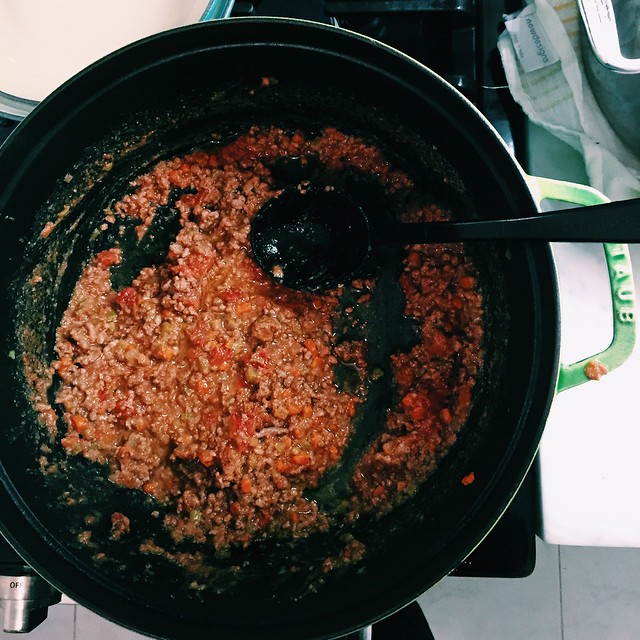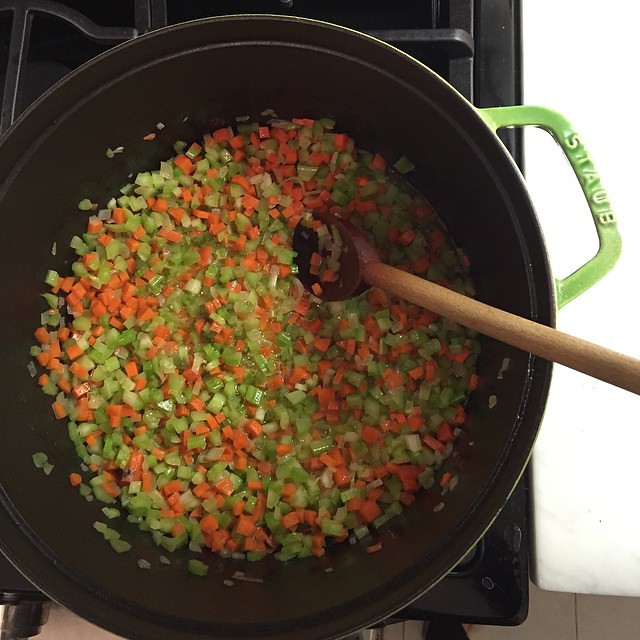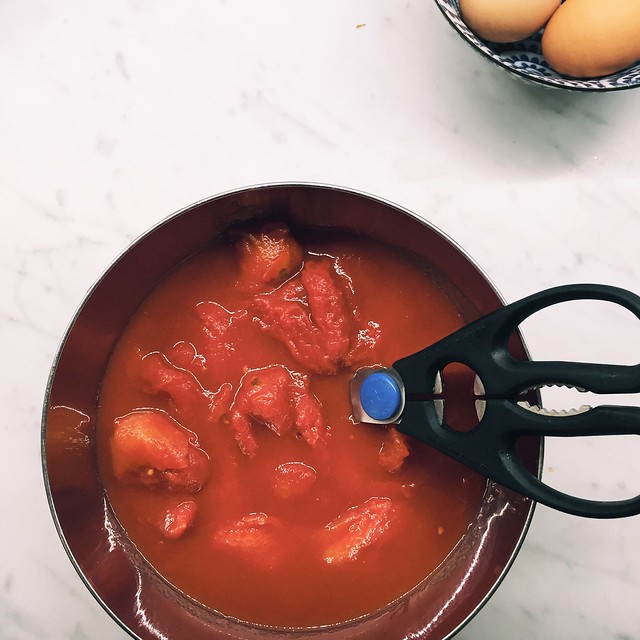marcella hazan’s ragu bolognese
As I inch towards the finish line with this pregnancy, I’m also getting closer to completely filling up my freezer. Space is of the essence, so I’m playing this game of shifting things around to make room. All the butter (and I mean all the butter) has been moved to the fridge. The frozen bananas I originally intended to use in smoothies and then promptly forgot about, wound up in the garbage. There’s also a bag of polenta now in the fridge, and will, no doubt, make a fine meal one night this month. As part of cooking on weekends to have weekday meals, I inadvertently started the “nesting” process of stocking the freezer a few months ago. There is my favorite chili and pulled Santa Fe chicken made in a crockpot; soups for days: red lentil, chicken, Vermont cheddar, parsnip leek; Marcella Hazan’s tomato butter sauce; and a whole roasted chicken (Ina’s recipe) from Andrew’s mom which now resides in a giant ziploc bag; and because it’s winter, meatballs (two kinds) and Marcella Hazan’s ragu bolognese. I figured that if we supplement it all with take-out a few days a week, we should be good for a month. I’m also hoping to try to get into cooking as soon as I can, even if it’s just a fried egg.
You would think that seeing the full contents of my freezer would make me cease this madness, but clearly pregnancy makes you insane, because the other day, I peeked inside the freezer and decided that we didn’t have enough of the bolognese. When I told Andrew I was making another double-batch, he simply looked at me, Are you sure you want to spend a whole day on this?
Yes, I said, it’s worth it, and we’ll be so glad to have it.
My go-to bolognese recipe, adapted barely from Marcella Hazan, is something I’ve arrived to after many years, and I feel very strongly about it. I love it so much, I won’t deviate from it at all, and after many years of making various bolognese versions, I feel like I’ve arrived at the one that serves me well. The ragu, which takes a day to make, is unflinchingly and uncompromisingly time consuming. There are no short-cuts; you cannot skip a step and hope to get the same remarkable results. You’re either in for the long-haul – pick a day when you will be home puttering around – or you’re not. And it’s the kind of thing you want to make a double batch of (or quadruple as some friends of mine) and freeze a lot for later. Since you’re spending the whole day making it, why not make a lot?
In my lifetime I’ve eaten much ragu bolognese. I’ve seen it made with seemingly countless variety of ways: with beef alone; with beef and pork; with beef, veal, and pork; with just pork; with boar; with short ribs; with milk; without milk; with red wine; with white wine; in under two hours; in as long as most of the day. I’ve had it with egg pasta and dry pasta (but never with spaghetti).
Bolognese is polarizing, with as many versions and opinions as there are people making it. And the debate can get pretty heated, with everyone staking a claim that theirs (or their grandmother’s) is the most authentic and delicious there is. I suppose in the end it comes to your taste buds and what you ate as a child – authenticity be damned. And if, like me, you grew up without an Italian grandmother reared in Emilia-Romana, well, you just have to search until you find the ragu of your dreams.
But if I had to, crassly, put people into Bolognese categories, it would come down to this: white wine or red. I did a very web search on why one wine might be more appropriate to the region and thus “correct”, but I didn’t find much. I consulted another Italian food guru, Mario Batali – or rather I consulted his books – and his choice of wine, for ragu bolognese, is white.
I think the white wine makes for a better melding of flavors. It’s less tannic, more delicate, and as it cooks down and the its flavor is absorbed by the meat, it provides the necessary acidity and complexity without the harshness of the red. But, of course, it’s a matter of opinion.
For years, I paired my bolognese with red, cooked it for about three hours, browned my vegetables (a la Anne Burrell), and never questioned a thing. The ragu was robust, punchy, filling – it was very, very good. For years it was my go to, and then one day a few years ago, I was flipping through one of my favorite cookbooks, “Essentials of Classic Italian Cooking” by Marcella Hazan, when I came upon her recipe for ragu bolognese.
Hazan’s book is minimalist in the approach. No illustrations, no photographs. Just plain text devoid of overly flowery language. Efficient and to the point. Preceding the ragu bolognese are some bullet points, list style.
One: the meat shouldn’t be too lean; more marbled meat, gives you sweeter ragu. In other words, fat is your friend.
Two: salt the meat immediately to extract its juices.
Three: Add the wine and tomatoes only after all of the milk has been absorbed: it prevents the acidic bite of the latter.
Four: Don’t use demiglace or other concentrates that “tip the balance of flavors towards harshness”.
Five: Use a pot that retains heat, preferably earthenware which is us by most cooks in Emilia Romagna, but enameled cast-iron pots (my pot of choice) are, in Marcella’s view, “fully satisfactory”.
And six: cook the sauce uncovered, at the merest simmer, for a “long long time; no less than 3 hours is necessary, more is better.”
You can see then, after such strict guidelines that I follow the recipes mostly to the letter of the law. I certainly take the whole day to cook it; and if it’s a nasty, cold, and wet day, like one we had just this past weekend, it’s the perfect day to let the sauce simmer while you come back to it from time to time and tend to other matters – in the kitchen or otherwise.
If you’re the kind of cook that needs emotional nurturing from your cookbooks, Hazan’s recipes aren’t for you. She quickly dispenses with all that emotional stuff and gets right to the point. Rather than telling you to try to use this or that ingredient, she’s more direct with her “should” or “should not”. There’s no latitude with her. Instead there’s a right way and a wrong way – and that’s one of the reasons I like her books and writing. She is exacting, thorough, meticulous, and rather prescriptive, but rather than being confining, her demands are actually liberating. Here is Hazan teaching you how to cook a dish properly. Follow her lead, and you’re bound to wind up with something transcendent. Personally, like the stern approach. I’d much rather that than something wishy-washy.
Under no circumstances, she once wrote (I’m paraphrasing), should you cook your pasta sauce with the lid on. How else will you let evaporation occur and let the sauce thicken?
How else, indeed?
So, if someone ever makes you homemade ragu bolognese, never mind the day-long Marcella Hazan’s bolognese, make no mistake – that’s an act of love. Treat this person well – and treasure them forever. To spend an entire day over a pot of ragu, hovering thus, is nothing if not love. Make a large batch, serve it over egg pappardelle (its ideal pairing), and be amazed. If you’re a kind and generous soul, unlike myself these days as I hoard and squirrel away provisions, take another batch over to a good friend who might need some warm, hearty sustenance. If they know what’s on their hands, they’ll never stop feeling grateful. You, on the other hand, may need to make another batch, stat. But since we’ve a few more months of cold and dreary winter, staying at home to make a large pot of this ragu seems like a great – and delicious – way to fill up your day.
Marcella Hazan’s Ragu Bolognese
Adapted from Essentials of Classic Italian Cooking
My modifications to the recipe are slight and have more to do with my deep adoration of pork (it makes for a more delicate cooked meat). Instead of a 2:1 beef to pork ratio, I make it more like 1:1, so for each pound of beef, I use a pound of pork. I’ve inched the amount of vegetables ever-so-slightly for easier adaptation, but I don’t think 1/4 cup here or there will make much difference.
2 tablespoons olive oil
6 tablespoons unsalted butter plus 2 tablespoons for tossing the pasta
1 cup chopped onion
1 1/2 cups chopped celery
1 1/2 cups chopped carrot
1 pound (454 grams) ground beef chuck (preferably 80% lean)
1 pound (454 grams) ground pork (preferably from the neck or Boston butt)
Kosher salt
Freshly ground black pepper
2 cups (473 ml) whole milk
1/4 teaspoon freshly ground nutmeg
2 cups (473 ml) dry white wine
3 cups stewed tomatoes from 1 (28-ounce can / about 800 grams) , cut up, with their juice
Fresh egg pasta
Parmigiano-Reggiano, for grating table-side
1. In a large wide pot set over medium heat, preferably an enameled Dutch oven (8 quarts is my choice), combine the oil with 6 tablespoons of butter and warm both until the butter has completely melted. Add the onion and cook, stirring, until it becomes translucent, 4 to 5 minutes. Add the celery and carrot and cook, stirring the vegetables until well coated, 2 to 3 minutes.
2. Add the meat, a generous pinch or two of salt, and some pepper. Cook the meat, stirring and crumbling it with a wooden spoon, until the meat has lost its raw red color. add the milk, and let it simmer gently, stirring frequently, until it has bubbled away completely. You may need to lower the heat for this; and this step may take about an hour or a bit longer. You may want to walk away for half an hour, do something else, and come back to check on the sauce. Once the milk has all absorbed, add the nutmeg and stir to combine.
3. Add the wine; let it simmer until it has evaporated – again, this step could take an hour plus. Be patient with the sauce and don’t add the next liquid before the current one is all absorbed by the sauce. This is how you build flavor.
4. Add the tomatoes and stir them into the sauce. When the tomatoes begin to bubble, turn the heat down so that, as Marcella writes, “the sauce cooks at the laziest of simmers, with just an intermittent bubble breaking through to the surface.” Cook the bolognese, uncovered, for 3 hours or more, stirring from time to time. While the sauce is cooking, you may find that it begins to dry out, with the fat separating from the meat. Add 1/2 cup of water, whenever necessary, to keep it from sticking. At the end, however, there should be not water at all left, and the fat must separate from the sauce. Taste and adjust the salt, if needed. At this point you can either toss the sauce with cooked, drained pasta (with that pat of butter leftover) or, if you’re like me, you can put the sauce in the fridge and let it sit overnight (which further develops the flavors). You can also freeze this sauce for a rainy, or snowy, day. Or in my case – month one of motherhood.
This whole mess will feed about 8 people, so you may want to double this recipe (which is double what the book instructs) – and freeze the rest. Of course, if you happen to share your bolognese, this officially makes you a saint, or something like it anyhow.




Erin
We just got back from 2 weeks in Italy, and to my amazement, I ate more pasta (of all shapes and types) with Ragu Bolognese than any other food. It was just the most consistently fantastic thing we ate at almost every single restaurant. Thanks for this! It will be the first thing I make when we are ready to eat pasta again!
Vicki A.
Um..beef chick?
Jan Schultz
My dear Olga,
I love Marcella Hazan. I have her cookbook, The Classic Italian Cookbook published by Knopf in 1988. For her Ragu Bolognese she first adds the dry white wine and cooks it with the meat and chopped veggies at medium high heat until all the wine has evaporated. then she turns down the heat to medium and adds the milk and nutmeg. This is the way i have made ragu for decades alla Marcella. Is there a culinary reason why you choose to add the milk before the wine?
olga
Vicki – chuck, thanks for the heads up! Very kind of you to notice!
olga
Jan – I followed the recipe’s every step – and in the book, she instructs milk comes first – before anything acidic. She’s pretty adamant about it actually. Perhaps you are working with an older edition? The one I have is fairly recent (I believe published in 1992).
Christine
Oh Marcella. After moving multiple times from college on I really pared down my cookbook collection, but hers I kept. Her pork chops with spring onions (or scallions, a suggestion and a delicious one) are one of the first things I’ve ever made of hers and just gorgeous and so easy and so so delicious.
http://www.foodandwine.com/recipes/sauteed-pork-scallops-with-scallions-and-capers
Christine
(Oh and here’s to hoping you get back in the kitchen as soon as you’d like. I found that I did a lot more cooking than I anticipated on maternity leave)
alice medrich's best cocoa brownies | Sassy Radish
[…] Radish « marcella hazan’s ragu bolognese Monday, January 19, […]
Joel
Greetings from Houston! I have been following your blog for a couple years. Always love reading it. Making this tomorrow, just got back from the store, plan to make it precisely as written. That’s hard for me because I slop together everything I make. Oddly I have been obsessed with the “authenticity” of seemingly endless and conflicting Bolognese recipes that i have tried the last few months. The milk/white wine intrigues me here. I will report back. Old friends coming for dinner Saturday and I’m making a double batch as I normaly do.
olga
Joel – I totally understand the desire to throw it all together at once – and I don’t blame you. I fell into a similar obsession and went through batches and batches of different bolognese. In the end, this, to me, is just spectacular and trumps others, and worth the investment of time. Let me know how it goes – and I recommend a double batch for sure! :)
Lalitkhatri
its very helpful to me.
What I'm Reading | January 2015 | Go Tripping
[…] soup for winter. And the ragu I need in my […]
gong bao chicken with peanuts | Sassy Radish
[…] or meals that come together in a flash. And I’ve gone so far as to make Marcella Hazan’s bolognese while Andrew’s mom helped to watch Avi. But what I’ve stayed away from was opening cookbooks […]
JoannaNYC
Jan and Olga, you are both right. I taught myself to cook from Hazan’s original “The Classic Italian Cook Book” and “More Classic Italian Cooking” in the 80’s. Later, my worn out paperbacks were replaced by her 1992 “Essentials of Italian Cooking.” The original Bolognese had wine first and less mirepoix. I prefer her later tweaks, the milk being first softens the meat and the additional mirepoix adds to the flavor.
olga
JoannaNYC – thank you!! Mystery solved :) I was wondering about that discrepancy!
We Eat: Morning Glory Muffins | Amendance
[…] Wednesday- Pasta with Ragu […]
Marcella Hazan’s Ragu Bolognese | arcisfoodblog
[…] Hazan’s recipe on the The New York Times website, but ended up following the one over at Sassy Radish as it already was roughly the quantity I usually make and had a bit more guidance on the cooking […]
Megan
This sounds amazing. One question: In step four you say the fat must separate from the sauce…do you skim off the fat in the end?
olga
Megan – sorry this is such a late response – i’ve been a bit swamped with work and baby! No need to skim off fat, you need it for all the flavor. It’s just so you see that the fat is there and not to freak out and think the recipe got all screwed up! :)
Podcast 62 - Kelsey Miller - The Actor's Diet
[…] Borscht Recipe, this Ragu Sauce, Vegan Poutine, and the joy of […]
Steve Williams
Marcella, this is the best bolognese sauce I ever had. Thanks for sharing your tips. Next time I’ll double the recipe ;-)
CB
Oh no! I didn’t wait nearly an hour for the milk or wine to fully evaporate. Is my bologenese ruined? I’m cooking it for 5 hours